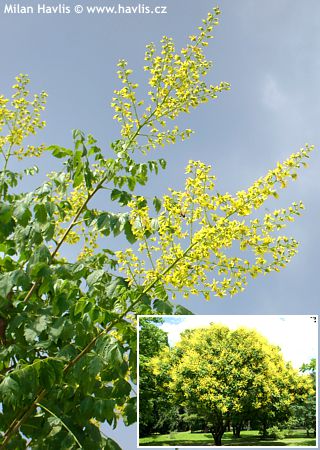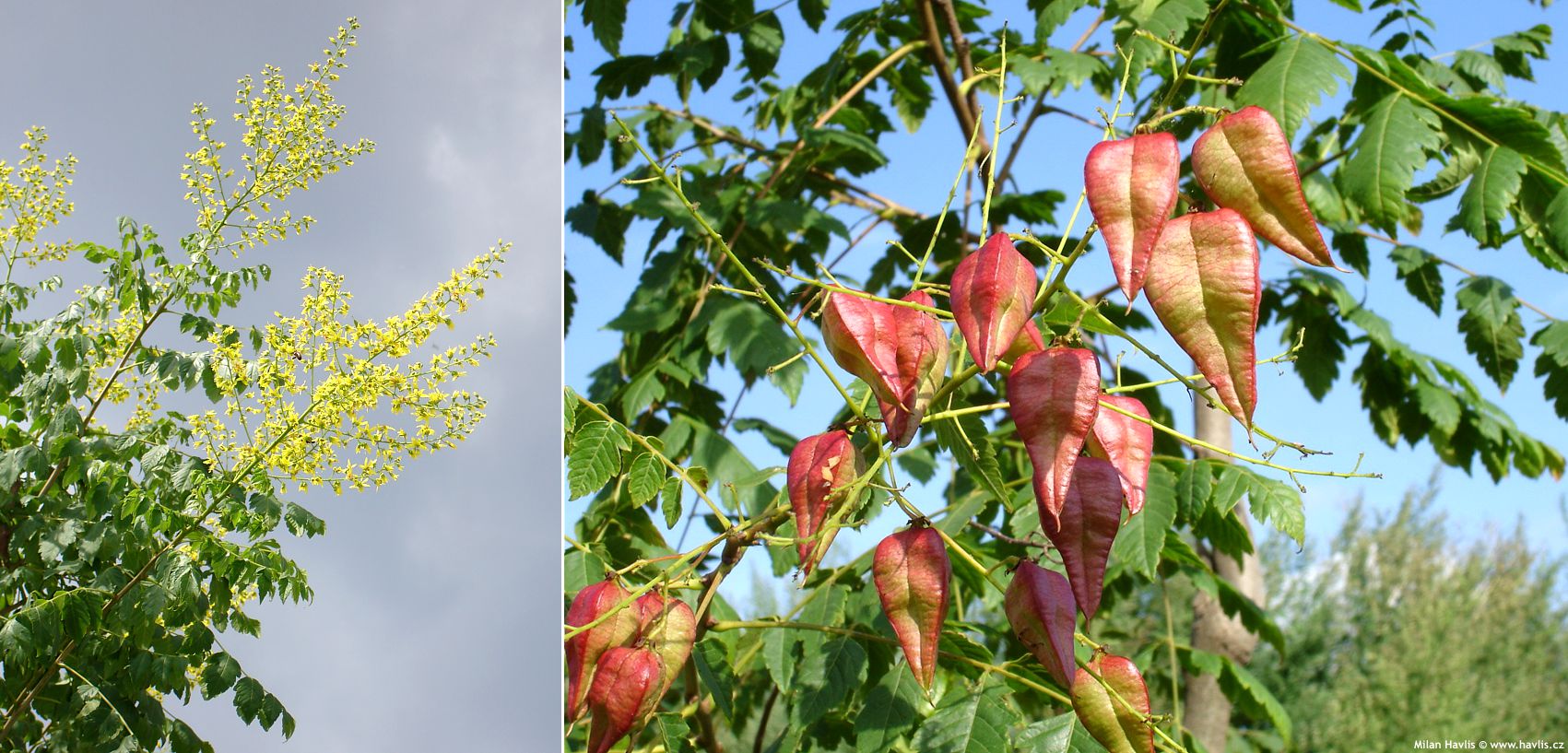Koelreuteria paniculata golden-rain tree


The species of golden-rain tree begins to bloom around mid-summer and makes beautiful, 30 to 40 cm long panicles, which are abundantly covered with small, deep yellow flowers with less conspicuous red eye. They bloom for up to 4 weeks and some of the latest flowers often appear along with attractive seedpods that look like hanging lanterns that ripen to bright salmon pink colour. The seeds are rather viable and germinate easily on unmaintained areas. In countries with a hot climate they form thickets over time which is why they are somewhere classified invasive, e.g., S.E. USA.
Another highlight are the exotic pinnate leaves whose individual leaflets are unevenly notched at margins, making the compound foliage look like lace. They are 20-45 cm long, exceptionally bipinnate, and emerge among the latest of all deciduous trees (albizia, campsis, hibiscus). Young leaves are pink or copper orange in spring, ripen to bright green in summer, and turn either fiery orange and red or just golden yellow in autumn. Their autumn colour is determined by the genetic information which may vary seed to seed. Still, by using highly acidic soil you can enhance autumn colours.
Golden-rain tree grows moderately to fast (30-40 cm per year), naturally into a multi-stemmed shrub, but in nurseries it is more often trained into a single-stemmed alley tree with a strong leader. The canopy is almost spherical to dome-shaped with age. Pruning is not necessary but can be done in early spring before the sap rises but after the danger of strong frost. Hard pruning is also possible – leaving only some 20-30 cm of previous year's branches will result in rapid growth of long canes with extra-large leaves but may endanger profuse flowering if cut too hard. The canopy casts a pleasant, not too dark shade, allowing the cultivation of semi-shade loving plants under it.
Although this tree belongs among small to medium-sized, its cultivation in private landscapes is still quite rare and certainly deserves a wider spread. In gardens its usual height and spread is between 5 and 7 m, while in parks and arboretums with unlimited root space it can grow twice as much. It can take almost any but waterlogged soil, it tolerates road salt and urban pollution. For abundant flowering, it needs a sunny and warm place and a nice summer. Every tree needs a strong support for the first 3-4 years from transplanting and no turf above its roots. Plants older than 3 years are fully hardy to min. -30 °C (USDA zone 5) and can allegedly cope with short spells down to -34 °C temporarily.
Last update 08-12-2008; 04-10-2014; 14-02-2024
Goods are shipped all over Europe. For Russia and U.K. and for further details please read about SHIPPING OPTIONS HERE.
Are you interested in a serious discount for orders NOV-FEB? Check your options here.
THE PRICES INCLUDE VAT of 15%. For quick conversion you can use 1 CZK = approx. 0.04 EUR
- STANDARD QUALITY - Plants of this group are 1st class quality with number of branches and overall density adequate to their size and age, considering they were container grown.
- DE LUXE QUALITY - This label guarantees a luxurious quality of manually selected plants that, compared to their height and age, are exceptionally dense and beautiful.
- EXTRA - These plants are usually mature and bigger specimens with exceptional overall appearance.
- STANDARD (as described in the plant form) means a tree with a trunk of 190-210 cm and a crown at the top, unless specified differently. The commercial size for trees is their girth measured in the height of 1m from ground.
- HOBBY - These plants are of the same quality as our standard-quality plants but younger and therefore cheaper.
- SHRUB - a woody plant with branches growing bushy from the ground level.
- HALF-STANDARD or MINI-STANDARD - a small tree with shorter trunk, its size is usually specified.
- FEATHERED - These are trees with branches growing already from the base of the trunk and up along the stem.
- GRASSES and PERENNIALS - Sizes given usually read the diameter of the pot or the clump, as specified.
















